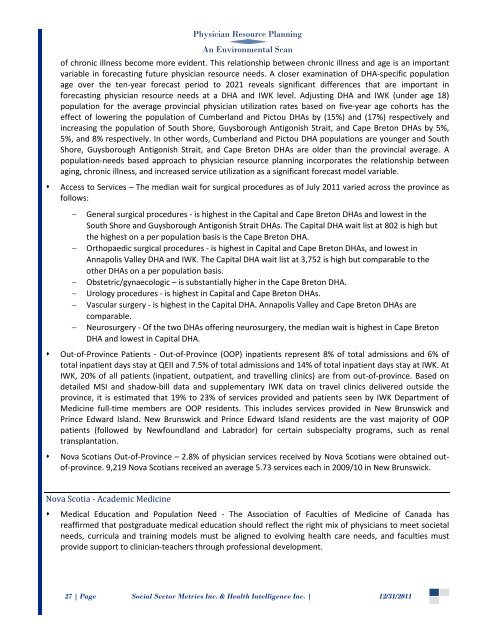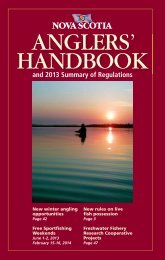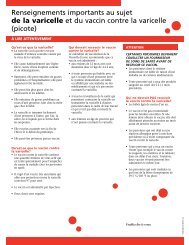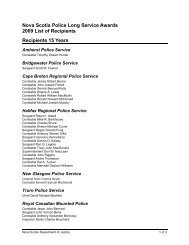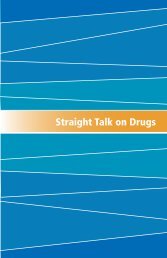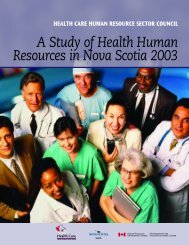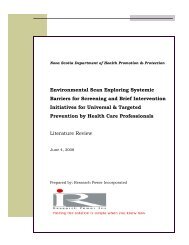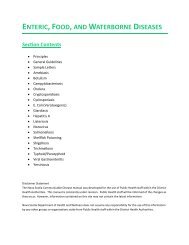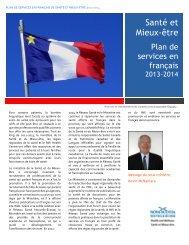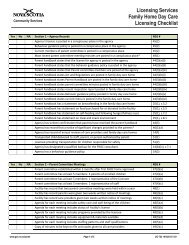Environmental Scan - Government of Nova Scotia
Environmental Scan - Government of Nova Scotia
Environmental Scan - Government of Nova Scotia
Create successful ePaper yourself
Turn your PDF publications into a flip-book with our unique Google optimized e-Paper software.
Physician Resource PlanningAn <strong>Environmental</strong> <strong>Scan</strong><strong>of</strong> chronic illness become more evident. This relationship between chronic illness and age is an importantvariable in forecasting future physician resource needs. A closer examination <strong>of</strong> DHA-specific populationage over the ten-year forecast period to 2021 reveals significant differences that are important inforecasting physician resource needs at a DHA and IWK level. Adjusting DHA and IWK (under age 18)population for the average provincial physician utilization rates based on five-year age cohorts has theeffect <strong>of</strong> lowering the population <strong>of</strong> Cumberland and Pictou DHAs by (15%) and (17%) respectively andincreasing the population <strong>of</strong> South Shore, Guysborough Antigonish Strait, and Cape Breton DHAs by 5%,5%, and 8% respectively. In other words, Cumberland and Pictou DHA populations are younger and SouthShore, Guysborough Antigonish Strait, and Cape Breton DHAs are older than the provincial average. Apopulation-needs based approach to physician resource planning incorporates the relationship betweenaging, chronic illness, and increased service utilization as a significant forecast model variable.Access to Services – The median wait for surgical procedures as <strong>of</strong> July 2011 varied across the province asfollows:−−−−−−General surgical procedures - is highest in the Capital and Cape Breton DHAs and lowest in theSouth Shore and Guysborough Antigonish Strait DHAs. The Capital DHA wait list at 802 is high butthe highest on a per population basis is the Cape Breton DHA.Orthopaedic surgical procedures - is highest in Capital and Cape Breton DHAs, and lowest inAnnapolis Valley DHA and IWK. The Capital DHA wait list at 3,752 is high but comparable to theother DHAs on a per population basis.Obstetric/gynaecologic – is substantially higher in the Cape Breton DHA.Urology procedures - is highest in Capital and Cape Breton DHAs.Vascular surgery - is highest in the Capital DHA. Annapolis Valley and Cape Breton DHAs arecomparable.Neurosurgery - Of the two DHAs <strong>of</strong>fering neurosurgery, the median wait is highest in Cape BretonDHA and lowest in Capital DHA.Out-<strong>of</strong>-Province Patients - Out-<strong>of</strong>-Province (OOP) inpatients represent 8% <strong>of</strong> total admissions and 6% <strong>of</strong>total inpatient days stay at QEII and 7.5% <strong>of</strong> total admissions and 14% <strong>of</strong> total inpatient days stay at IWK. AtIWK, 20% <strong>of</strong> all patients (inpatient, outpatient, and travelling clinics) are from out-<strong>of</strong>-province. Based ondetailed MSI and shadow-bill data and supplementary IWK data on travel clinics delivered outside theprovince, it is estimated that 19% to 23% <strong>of</strong> services provided and patients seen by IWK Department <strong>of</strong>Medicine full-time members are OOP residents. This includes services provided in New Brunswick andPrince Edward Island. New Brunswick and Prince Edward Island residents are the vast majority <strong>of</strong> OOPpatients (followed by Newfoundland and Labrador) for certain subspecialty programs, such as renaltransplantation.<strong>Nova</strong> <strong>Scotia</strong>ns Out-<strong>of</strong>-Province – 2.8% <strong>of</strong> physician services received by <strong>Nova</strong> <strong>Scotia</strong>ns were obtained out<strong>of</strong>-province.9,219 <strong>Nova</strong> <strong>Scotia</strong>ns received an average 5.73 services each in 2009/10 in New Brunswick.<strong>Nova</strong> <strong>Scotia</strong> - Academic MedicineMedical Education and Population Need - The Association <strong>of</strong> Faculties <strong>of</strong> Medicine <strong>of</strong> Canada hasreaffirmed that postgraduate medical education should reflect the right mix <strong>of</strong> physicians to meet societalneeds, curricula and training models must be aligned to evolving health care needs, and faculties mustprovide support to clinician-teachers through pr<strong>of</strong>essional development.27 | Page Social Sector Metrics Inc. & Health Intelligence Inc. | 12/31/2011


